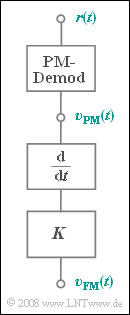Difference between revisions of "Aufgaben:Exercise 3.7: Angular Modulation of a Harmonic Oscillation"
m |
m (→Questions) |
||
| Line 33: | Line 33: | ||
<quiz display=simple> | <quiz display=simple> | ||
| − | { | + | {Which statements are definitely true? |
|type="[]"} | |type="[]"} | ||
| − | + | + | + There could be a PM modulation. |
| − | + | + | + There could be a FM modulation. |
| − | - | + | - The message phase is definitely $ϕ_{\rm N} = 0$. |
| − | + | + | + The message phase is definitely $f_{\rm N} = 10 \ \rm kHz$. |
| − | { | + | {Calculate the signal $v_{\rm PM}(t)$ after the phase demodulator. What is the signal value at time $t = 0$? |
|type="{}"} | |type="{}"} | ||
$v_{\rm PM}(t = 0) \ = \ $ { 1.5 3% } $\ \rm V$ | $v_{\rm PM}(t = 0) \ = \ $ { 1.5 3% } $\ \rm V$ | ||
| − | { | + | {Calculate the signal $v_{\rm FM}(t)$. What is the message phase $ϕ_{\rm N}$? |
|type="{}"} | |type="{}"} | ||
$ϕ_{\rm N} \ = \ $ { 90 3% } $\ \rm Grad$ | $ϕ_{\rm N} \ = \ $ { 90 3% } $\ \rm Grad$ | ||
| − | { | + | {How should $K$ be chosen so that the amplitude of $v_{\rm FM}(t)$ is equal to $1.5 \ \rm V$ ? |
|type="{}"} | |type="{}"} | ||
$K\ = \ $ { 6.28 3% } $\ \rm \cdot 10^4 \ 1/s$ | $K\ = \ $ { 6.28 3% } $\ \rm \cdot 10^4 \ 1/s$ | ||
| − | { | + | {Which of the following statements is true for the FM-modulated signal? |
|type="[]"} | |type="[]"} | ||
| − | + | + | + The phase deviation is $ϕ_{\rm max} = 3$. |
| − | + | + | + The frequenCY deviation is $Δf_{\rm A} = 30 \ \rm kHz$. |
| − | + | + | + Instantaneous frequencies between $0.97\ \rm MHz$ And $1.03 \ \rm MHz$ . |
| − | - | + | - If $f_{\rm N} = 5 \ \rm kHz$ , the phase deviation would be unchanged. |
| − | + | + | + If $f_{\rm N} = 5 \ \rm kHz$ the frequency deviation would be unchanged. |
</quiz> | </quiz> | ||
Revision as of 14:25, 17 March 2022
The signal arriving at a receiver is:
- $$ r(t) = 3\,{\rm V} \cdot \cos \hspace{-0.05cm} \big[2 \pi \cdot 1\,{\rm MHz} \cdot t + 3 \cdot \cos(2 \pi \cdot 10\,{\rm kHz} \cdot t)\big]\hspace{0.05cm}.$$
$r(t)$ is an angle-modulated signal that was neither distorted nor influenced by noise during transmission.
The signals $v_{\rm PM}(t)$ and $v_{\rm FM}(t)$ result after ideal demodulation by means of
- a phase demodulator, given by the equation
- $$ v_{\rm PM}(t) = \frac{1}{K_{\rm PM}} \cdot \phi_r(t) \hspace{0.05cm},\hspace{0.3cm} {K_{\rm PM}} = 2\,{\rm V}^{-1}\hspace{0.05cm},$$
- a frequency demodulator, consisting of a PM demodulator, a differentiator and a constant $K$.
In order for all signals to have equal units, this constant $K$ is dimensionally constrained.
Hints:
- This exercise belongs to the chapter Frequency Modulation.
- Reference is also made to the chapter Phase Modulation and particularly to the section Signal characteristics with frequency modulation.
Questions
Musterlösung
- Aus der Gleichung für $r(t)$ kann lediglich abgelesen werden, dass es sich um eine Winkelmodulation handelt,
- nicht jedoch, ob eine Phasenmodulation (PM) oder eine Frequenzmodulation (FM) vorliegt.
- Aufgrund der Gleichung steht fest, dass die Nachrichtenfrequenz $f_{\rm N} = 10 \ \rm kHz$ beträgt.
- Die Phase $ϕ_{\rm N} = 0$ des Quellensignals würde dagegen nur zutreffen, wenn eine Phasenmodulation vorläge.
(2) Mit der Modulatorkonstanten $K_{\rm PM} = 2 \ \rm V^{–1}$ erhält man hierfür:
- $$v_{\rm PM}(t) = \frac{1}{K_{\rm PM}} \cdot \phi_r(t) = \frac{3}{2\,{\rm V}^{-1}} \cdot \cos(2 \pi \cdot 10\,{\rm kHz} \cdot t)\hspace{0.05cm}.$$
- Für den Zeitpunkt $t = 0$ gilt deshalb:
- $$v_{\rm PM}(t = 0) = {A_{\rm N}} \hspace{0.15cm}\underline {= 1.5\,{\rm V}}\hspace{0.05cm}.$$
(3) Für das Ausgangssignal $v_{\rm FM}(t)$ des FM–Demodulators – bestehend aus PM–Demodulator und Differenzierer – kann man schreiben:
- $$v_{\rm FM}(t) = \frac{{\rm d}v_{\rm PM}(t)}{{\rm d}t} \cdot K = \frac{K \cdot A_{\rm N}}{2 \pi \cdot f_{\rm N}} \cdot (- \sin(2 \pi \cdot {f_{\rm N}} \cdot t))= \frac{K \cdot A_{\rm N}}{2 \pi \cdot f_{\rm N}} \cdot \cos(2 \pi \cdot {f_{\rm N}} \cdot t + 90^\circ)\hspace{0.05cm}.$$
- Die Nachrichtenphase ist somit $ϕ_{\rm N} \hspace{0.15cm}\underline {= 90^\circ}$.
(4) In diesem Fall muss gelten:
- $$ K ={2 \pi \cdot f_{\rm N}} \hspace{0.15cm}\underline { = 6.28 \cdot 10^{4} \,\,{1}/{ s}} \hspace{0.05cm}.$$
(5) Richtig sind die Lösungsvorschläge 1, 2, 3 und 5:
- Der Phasenhub ist identisch mit dem Modulationsindex, der aus der angegebenen Gleichung abgelesen werden kann:
- $$\phi_{\rm max} = \eta = 3 = \frac{\Delta f_{\rm A}}{ f_{\rm N}} \hspace{0.05cm}.$$
- Damit erhält man den Frequenzhub $Δf_{\rm A} = 3 · f_{\rm N} = 30 \ \rm kHz$.
- Mit der Trägerfrequenz $f_{\rm T} = 1 \ \rm MHz$ kann somit die Augenblicksfrequenz $f_{\rm T}(t)$ nur Werte zwischen $1±0.03 \ \rm MHz$ annehmen.
Es gilt also auch folgende Aussage:
Bei halber Nachrichtenfrequenz verdoppelt sich der Phasenhub $η$, während der Frequenzhub $Δf_{\rm A}$ davon nicht beeinflusst wird:
- $$\eta = \frac{K_{\rm PM} \cdot A_{\rm N}}{ f_{\rm N}} = 6 \hspace{0.3cm}\Rightarrow \hspace{0.3cm}\Delta f_{\rm A} = \eta \cdot f_{\rm N} = 6 \cdot 5\,{\rm kHz} = 30\,{\rm kHz}\hspace{0.05cm}.$$
